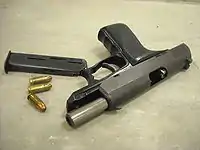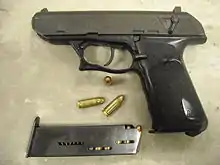Heckler & Koch P9
The HK P9 is a semi-automatic pistol from Heckler & Koch in 9×19mm Parabellum and the first to use a variation of H&K's roller delayed blowback system in a pistol format and polygonal rifling now common in H&K designs.
| Heckler & Koch P9 | |
|---|---|
 HK P9S with magazine | |
| Type | Semi-automatic pistol |
| Place of origin | West Germany |
| Service history | |
| In service | 1969-present |
| Used by | See Users |
| Production history | |
| Designer | Heckler & Koch Gmbh |
| Designed | 1965-1969 |
| Manufacturer | Heckler & Koch |
| Produced | 1969-c.1973 (P9/pre-73), 1973-1978 (P9S) |
| No. built | SAO:485; P9S: unknown |
| Variants | P9S, P9 SAO |
| Specifications | |
| Mass | 880 g (31 oz), empty (.45 ACP) |
| Length | 19.2 cm (7.5 in) |
| length | 10.2 cm (4 in) |
| Height | (5.4 in) |
Design

The P9 is a roller-delayed pistol manufactured from a stamped steel main frame and a polymer trigger guard. The stamped steel slide contains machined internal parts including a polygonally rifled barrel. High-profile fixed sights are fitted with two red rectangles on the rear sight and a white stripe on the drift adjustable front blade sight. Vertical zeroing is accomplished by fitting front sights of a different height.
The P9S trigger operates as a traditional double action. There is a lever on the left side of the pistol grip to both decock a cocked hammer or to manually re-cock it for a single action first shot, a feature first observed on the Sauer 38H. A further function of the decocking lever is to release the slide stop. The hammer is concealed within the slide (also similar to the Sauer) with a protruding pin at the rear of the slide as a cocking indicator. The operating spring surrounds the barrel, allowing for a lower bore axis than pistols such as John Browning's M1911 that have the operating spring below the barrel. A manual firing-pin safety is located at the left rear of the slide; putting it in the down position locks the firing pin and flipping it up to level position unlocks it.
Typical to European pistols, the magazine release is heel-mounted. The magazine is single column.
Production and variants
The design-work began around 1965, with the first series (known as "pre-73" or just P9 without S) being produced between 1969-1973. 485 single-action P9's were produced before being discontinued.
A traditional double action version, the P9S (the S standing for Spannabzug, or "double-action trigger") was manufactured in greater numbers, from 1973 all the way up to 1978, until being discontinued again.
The P9S was adopted by the US Navy for use with a sound suppressor.[1] The sound suppressors of the period were comparatively large and the model frequently shown with the P9S make the pistol's sights unusable so the suppressor was equipped with sights. The fixed barrel of the P9S allows the pistol to operate reliably with the suppressor attached without requiring the recoil booster most long and short recoil designs need to compensate for the added muzzle mass and mechanical movement of a mounted suppressor.
A shortened version, the P9K (the K standing for Kurz, or "short") was made in prototype form. Until Theodor Koch's death in October 1976, four prototypes of a shortened version of the P9K were also produced, but was never put into production.
In addition to the standard P9S, a P9S Target model was also offered. This model included a taller front sight, a windage and elevation adjustable rear sight, an adjustable trigger over-travel stop, and an adjustable trigger that could be adjusted down to as low as approximately a 2.5# pull. The P9S Target model was offered in both 9mm as well as .45 ACP.[2]
Reception
As a service pistol, the P9S was used by numerous domestic and foreign police and military authorities as well as special forces units. There are also richly equipped sports sets with a long second barrel / breech, made-to-measure handles, sports sights, barrel weights (HK P9S-Sport Group II and III) as competition weapons for large-caliber sport shooting.
Domestically, the H&K P9S was adopted by the West German Federal Border Guard and the Saarland state police. Otherwise, the H&K P9S was not widely adopted by West German law enforcement agencies, which instead opted to adopt the newer generation of automatic pistols introduced in late 1970s, including Walther P5, SIG Sauer P225 (as P6) and H&K's own P7.
H&K P9S has been in use by the GSG-9, and alongside the S&W Model 66, it served as GSG-9 members' sidearm during the 1977 Lufthansa Flight 181 hijacking incident. [3] It was also used as a service pistol by the Japanese Metropolitan Police Department Special Assault Team (predecessor of the SAT).
The H&K P9S was adopted by US Navy. It has been replaced by Heckler & Koch's own Mark 23 pistol, as well as the later H&K HK45CT under the designation Mk 24 Mod 0.
Users

 Algeria: Algerian police[4]
Algeria: Algerian police[4] Argentina: Argentine Army (P9S variant).
Argentina: Argentine Army (P9S variant). West Germany: GSG9 and State police of Saarland.
West Germany: GSG9 and State police of Saarland. Greece: EP9S variant.[5]
Greece: EP9S variant.[5] Japan: Used formerly by the Special Armed Police[6]
Japan: Used formerly by the Special Armed Police[6] Lebanon:[7]
Lebanon:[7] Malaysia:Malaysian Armed Forces and Royal Malaysia Police.[5]
Malaysia:Malaysian Armed Forces and Royal Malaysia Police.[5] Netherlands: Brigade Speciale Beveiligingsopdrachten.[8]
Netherlands: Brigade Speciale Beveiligingsopdrachten.[8] Paraguay[5]
Paraguay[5] Portugal: Guarda Nacional Republicana (P9S variant).
Portugal: Guarda Nacional Republicana (P9S variant). Saudi Arabia[5]
Saudi Arabia[5] Spain: Grupo Especial de Operaciones (P9S variant).
Spain: Grupo Especial de Operaciones (P9S variant). Sudan[5]
Sudan[5] United States: U.S. Navy.[1]
United States: U.S. Navy.[1]
References
- Dockery, Kevin (2004). Weapons of the Navy SEALs. New York: Berkley Caliber. p. 55. ISBN 0-425-19834-0.
- Ayoob, Massad (1995). The Story Of The Great, Lost Nine. Los Angeles, CA: Petersen Pub. Co. p. 98. ISBN 0822732564.
- Neville, Lee "European Counter-Terrorism Unit" ISBN 978-4890633852.
- "World Infantry Weapons: Algeria". 2015. Archived from the original on 24 November 2016. Retrieved 11 January 2020.
- Jones, Richard D. Jane's Infantry Weapons 2009/2010. Jane's Information Group; 35 edition (January 27, 2009). ISBN 978-0-7106-2869-5.
- 大塚正諭「日本警察の拳銃」、『SATマガジン』、KAMADO、2009年1月、 50-57頁
- http://weaponsystems.net/weapon.php?weapon=AA01+-+P9
- "Archived copy". Archived from the original on 2011-09-30. Retrieved 2011-09-24.CS1 maint: archived copy as title (link)
External links
| Wikimedia Commons has media related to HK P9S. |